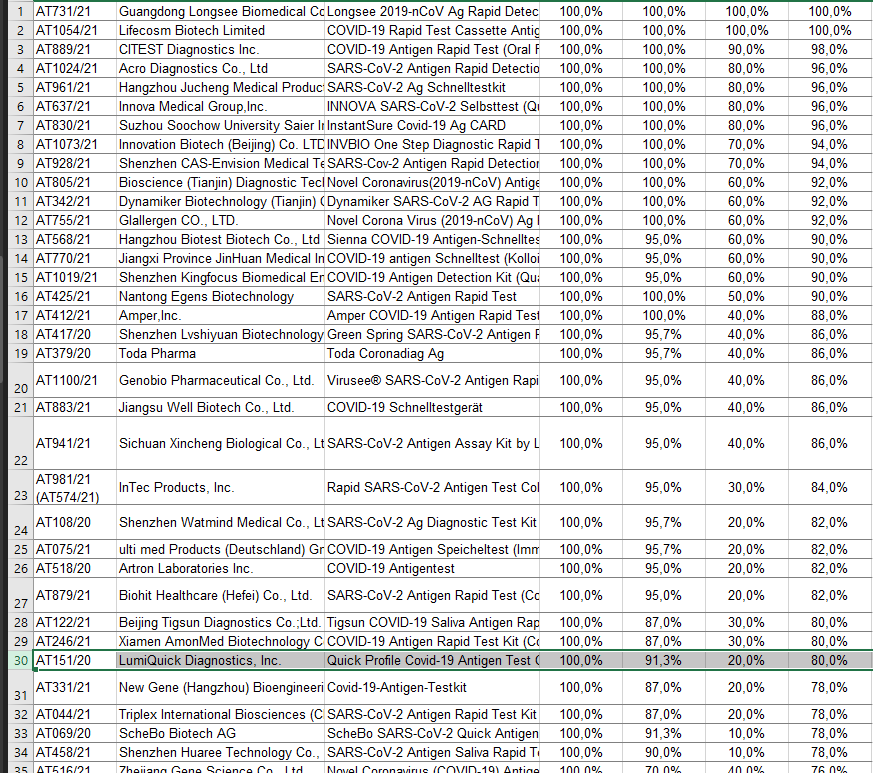Um mal was anderes als trübsinnige Kriegsberichte zu lesen: hier mal was lustiges aus der Corona-Kiste. Wie das mit den deutschlandweiten Zahlen ist, habe ich spontan nicht verfügbar, aber aus den Zahlen für NRW lässt sich klar etwas ableiten:
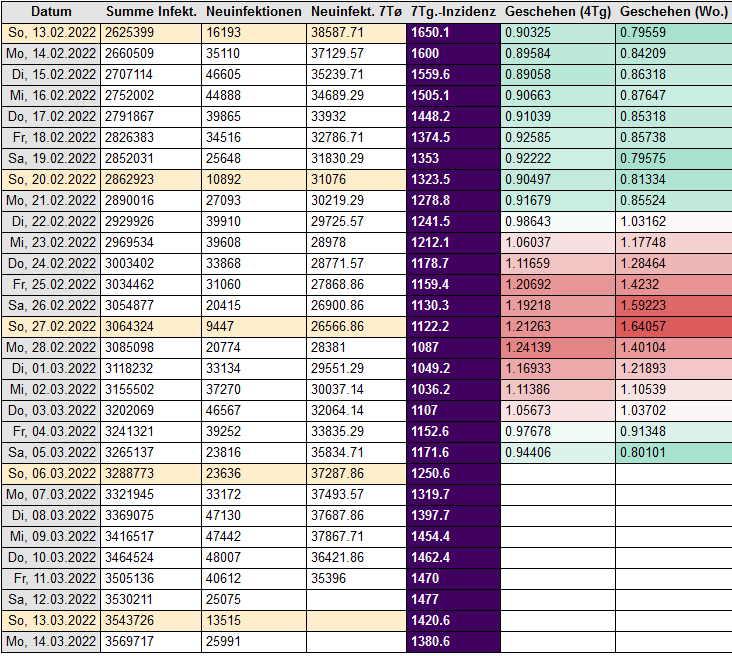
Die die Zahlen in den 2 „Geschehen“-Spalten am rechten Rand sind so etwas ähnliches wie ein nachträglicher R-Wert, oder einfacher gesprochen: sie zeigen an, ob die Pandemie an diesem Tag gerade Fahrt aufnimmt – und zwar wenn der Wert größer als 1 ist – oder abklingt – dann ist der Wert kleiner als 1. Zur besseren Übersicht wird der Zellhintergrund für Werte über 1 mit zunehmendem Abstand roter, und unter 1 entsprechend grüner (außer für Rot-Grün-Farbfehlsichtige natürlich, für die die Farben allerdings zumindest unterscheidbar sein sollten). Ich hänge hinten ein paar technische Details an.
OK – wo ich eigentlich drauf hinaus will: ich denke bei näherer Betrachtung, seht Ihr auch, was ich gesehen habe: offenbar gab es einen deutlichen Anstieg der Infektionsrate am und um das Wochenende 26./27. Februar. Aha. Und … was war da? Richtig: Karneval, Ihr Jecken! Kamelle!
Für etwas aktuellere Zahlen schaut bitte hier. Wenn die Zahlen dort etwas von denen im Bild abweichen, liegt das daran, dass das Land offenbar die Zahlen der letzten 1 oder 2 Tage noch nachträglich anpasst (also Nachträge einpflegt).
Aber zurück zum Ernst der Lage. Tatsächlich hat zumindest in NRW die Zunahme der Inzidenz also ganz klar nichts mit irgendwelchen Omikron-BCD-47.12-Varianten zu tun sondern schlicht – und wie so oft – mit der Unvernunft der Leute.
Ob die geplanten oder auch schon wieder nicht mehr geplanten oder nur in Teilen umsetzbaren, oder von den Ländern zu entscheidenden oder sonstwie gedingsten „Öffnungsschritte“ sinnvoll oder gefährlich oder gewagt oder überfällig oder viel zu früh oder rechtseinknickerisch oder alleszusammen sind, mag jeder für sich entscheiden. Fakt ist: wenn wir in unserem schönen Bundeslande der jecken Sturköppe uns nicht besoffen in den Armen liegen oder Bützje an wildfremde Passanten verteilen, sondern uns mit Masken, Abstand und Anstand begegnen, dann wirken die Impfungen offenbar immer noch super und wir kommen locker durch das Frühjahr. Zumindest hier in NRW.
Man müsste jetzt mal rausfinden, weshalb das in anderen Ecken offenbar anders ist. Liegt das an mangelnder Impfbereitschaft? Oder sind die anderswo schlicht sozialinteraktiver oder gar kuscheliger drauf? Stärkt der alltägliche Kampf im Spannungsfeld zwischen norddeutsch-distanzierten Westfalen und süddeutsch-vielschichtigen Rheinländern das Immunsystem? Fragen über Fragen und niemand, der das eigentlich so genau wissen will.
Gut. dann kommen jetzt noch die angedrohten, technische Ergänzungen für den interessierten Leser …
Die beiden rechten Spalten geben den über 7 bzw 3 Tage gemittelten Wachstumsfaktor der Neuinfektionen über die vergangenen 4 bzw. 7 Tage hinweg, versetzt um 9 Tage in die Vergangenheit wieder – klingt kompliziert … naja gut … isses auch. Ich habe das ganze auch noch mal als Tabellenkalkulation (leider mit etwas anderer Farbgebung, aber ansonsten identisch). Also machen wir da mal ein Bild dazu …
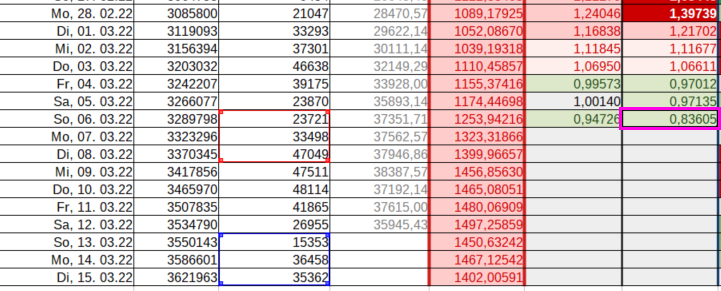
Erklärung: das in dem rosa Kästchen (letzte Zahl des Wochen-Wachstums-Faktors bzw. der Spalte „Geschehen (Wo.)“) ergibt sich, indem das blaue Kästchen geteilt wird durch das rote Kästchen (ob man die Summe oder den Durchschnitt der Kästchen nimmt, ist in diesem Fall – da es gleich viele Einzelwerte sind – egal, man muss nur für beide Dreierpacks dasselbe machen).
Warum 3-Tage-Mittelwert und 7 Tage Abstand? Der Durchschnitt über 3 Tage glättet die resultierende Kurve etwas, indem es zum Beispiel Schwankungen durch Feiertage etwas ausgleicht. Die 7 Tage Abstand gleichen die Schwankungen durch die Wochenenden aus.
Der Wert, der sich aus obiger Rechnung ergibt, kann natürlich erst am letzten Tag vom blauen Kästchen ermittelt werden. Durch das „hochschieben“ um 9 Tage werden die zu dem Zeitpunkt ermittelten Werte dann aber dahin verschoben, wo die am Ende im blauen Kästchen „gemessenen“ Infektionen tatsächlich stattgefunden haben. Die 9 Tage kommen zum einen aus den 3 bis 4 Tagen Inkubationszeit, dem Tag, den es dauert, das Ergebnis des PCR-Tests zu bekommen, dem Tag Verzug, weil heute erst die gestern bei den Ärzten angekommenen PCR-Test-Ergebnisse in den Statistiken landen und schließlich noch 3 Tagen, die sich aus der Wertermittlung ergeben (OK – tatsächlich habe ich das mal an einem Vatertag in 2020 feinjustiert und bin selber erstaunt, dass es immer noch gut passt – aber Ihr seht: es ist nicht völlig aus der Luft gegriffen).
Bei der Spalte davor (4-Tage-Wachstums-Faktor bzw. Spalte „Geschehen (4Tg)“) sieht das ganze so aus:
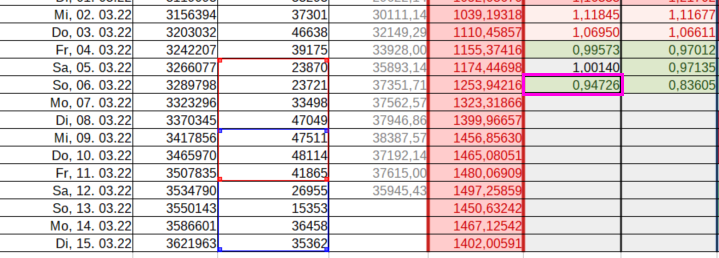
Es ist am Ende auch hier wieder bloß wieder blaues Kästchen geteilt durch rotes Kästchen. Hier werden die Wochenenden aber darüber ausgeglichen, dass über 7 Tage gemittelt wird. Der Abstand von 4 Tagen wurde von mir ursprünglich gewählt, weil ich den Eindruck hatte, damit den offiziellen „R“-Werten halbwegs nahe zu kommen. Das habe ich allerdings nie mathematisch nachgewiesen. Es entspricht, glaube ich, einem der „Schätzer“ für den R-Wert. Ich meine, das hätte mich damals darauf gebracht. Aber wie gesagt: das ist nix wasserdichtes.
Allgemein kann man sagen: bei der Durchschnittsbildung über 7 Tage werden die „Peeks“ stärker „auseinandergezogen“ als beim Wochenvergleich mit einem 3-Tage-Durchschnitt. Der Wochenvergleich ergibt also eine etwas schärfere Abgrenzung von Einzelereignissen (wie etwa dem Karnevalswochenende oder Sylvester). Der 4-Tage-Vergleich ist dafür zum Erkennen einer Tendenz etwas besser geeignet.
Der Vollständigkeit halber zeige ich auch noch, wie die 7-Tage-Inzidenz zustande kommt:
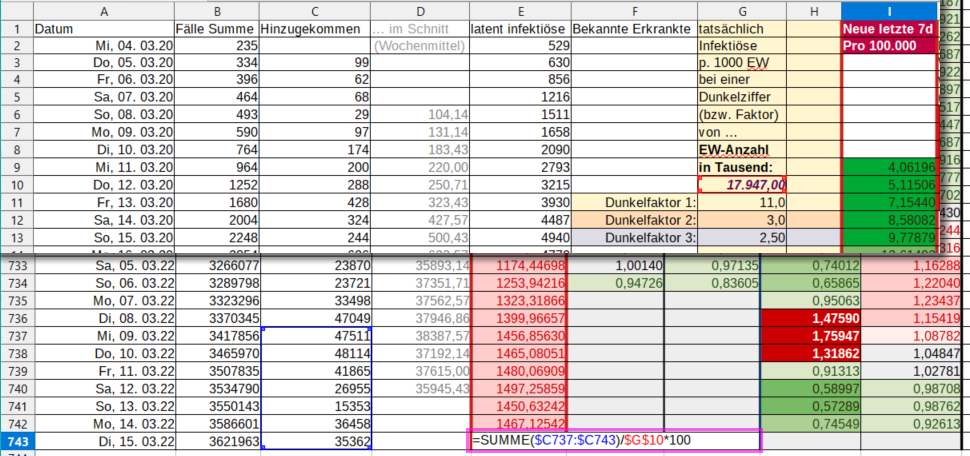
Es ist am Ende wieder schlicht (Summe) blaues Kästchen durch rotes Kästchen mal 100, womit im Ergebnis halt schlicht die Summe der Infektionen im blauem Kästchen so umgerechnet wird, als hätte NRW exakt 100.000 Einwohner (ich hab mir ein paar Nullen geschenkt – eigentlich ist der Faktor 100.000/17.947.000). Im oberen Bildausschnitt sind ein paar Spalten eingeblendet, die ich ansonsten ausgeblendet habe (die eine davon entspricht dem, was in „ca. Infektiös (‰)“ meiner Online-Tabelle drinsteht) – ich hab die da eingeblendet, weil ich eine Zelle dieser Spalten für die Einwohnerzahl „missbraucht“ habe und ich die hier zeigen wollte.
Der Inzidenzwert wird nicht nach oben geschoben, aber man muss sich trotzdem natürlich klarmachen, dass er eigentlich die Verhältnisse vor 9 Tagen abbildet. Will man eine Tendenz daraus ableiten, so sagt die etwas darüber aus, in welche Richtung die Reise vor knapp 2 Wochen gegangen ist.. Aber das ist ja inzwischen ein alter Hut.





